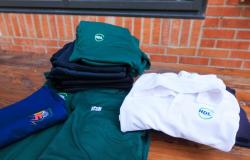(Matsusaka) Toshihide Takase produces Burgundy snails in Japan, a species considered impossible to breed. His know-how, developed as an autodidact over four decades, is now of great interest to France.
Published yesterday at 7:06 p.m.
Etienne BALMER and Caroline GARDIN
France Media Agency
Stuffed with garlic parsley butter and baked in the oven, “Burgundian style” snails have been a monument of French gastronomy since the 19th century.
But Burgundy snails (helix pomatia) have been protected since 1979 in France, because they were threatened with extinction. They are therefore collected in central and eastern Europe then exported, mainly to France, the world’s largest market.
Snail breeders, or snail farmers, also exist in France, but they focus on another species that is easier to produce, helix aspersa (the “petits-gris” and “gros-gris”), and represent only 5% of the national market.
“The Burgundy snail has never seen Burgundy, it’s ironic, but it’s true,” William Blanche, co-president of the National Federation of Heliculturists and breeder near Besançon (eastern France), told AFP. France).
The pomatia “is reputed to be impossible to breed […] because it cannot tolerate promiscuity and it takes a long time to grow, between two and three years,” recalls a French industrialist in the sector, preferring to remain anonymous.
“They called me an idiot”
Mr. Takase, 76, however, says he has managed to shorten the growing time of pomatia to just four months, like the French aspersa.
Nothing predestined him to become an expert in this field which is so atypical in Japan, where snails are rarely consumed and perceived as harmful to crops.
His other sectors of activity had nothing to do with gastropods either: his “snail development laboratory” in Matsusaka (central Japan) is installed behind a noisy metalworks, the first company created by this multi-entrepreneur today. now retired.
PHOTO PHILIP FONG, AGENCE FRANCE-PRESSE ARCHIVES
Toshihide Takase
His vocation came to him in 1979. “My sister had traveled to France and brought me some canned snails as a souvenir,” he tells AFP. “But it wasn’t good and it smelled bad. »
After this disappointing experience, he took on the crazy challenge of raising Burgundy snails: “I thought that only I could do it,” explains this stubborn man, proud to have been proven wrong. to everyone: “They called me an idiot.”
He devoured the literature on the subject, met helicopter farmers in France, and invested a small fortune. After seven years of administrative procedures, he obtained a breeding permit in Japan and the right to import 100 specimens of pomatia from France: “I was really moved, my heart was racing,” he relates, affirming to be “the only one in the world” to raise them.
“Monstrous marketing coup”
He says he now has the capacity to produce 600,000 per year. His snails live peacefully in trays arranged on sliding metal shelves, in expertly prepared humus-rich soil where he adds oyster shell powder, full of calcium: “They love it”.
The breeder took “twenty years” to develop a special food powder for his snails, based on soya and corn, packed with vitamins and calcium.
Hygiene is central to his breeding: feeders and water bowls are replaced every three days and washed by hand. “Snails like cleanliness,” explains Mr. Takase, who also constantly monitors the temperature and humidity level.

PHOTO PHILIP FONG, AGENCE FRANCE-PRESSE ARCHIVES
Toshihide Takase’s snails live peacefully in trays arranged on sliding metal shelves, in expertly prepared humus-rich soil where he adds oyster shell powder, full of calcium.
He now wants to pass on his method to French breeders, approached via the French embassy in Japan, and is also considering commercial partnerships with French manufacturers. But many questions remain.
“If tomorrow we knew how to raise pomatia, could we make a transition? Would our consumers, who are used to another type of snail, be up for it, and at what price? » asks Mr. Blanche, although seduced by the idea of visiting Mr. Takase’s breeding farm.
Such careful installations, entirely above ground, involve high costs: six other people work year-round with Mr. Takase, who for direct sales charges nearly 90 dollars (9,900 yen) for 30 snails.
“It’s very expensive, around four times the price of snails from French manufacturers and around double the prices from French breeders,” notes the industrialist interviewed by AFP.
And “it has to have flavor,” he warns, doubting for the moment that a farmed pomatia will be as tasty as a wild one with “a strong taste of undergrowth.”
“I would dream of having a French Burgundy snail,” confides this entrepreneur. “The marketing coup would be monstrous. »








